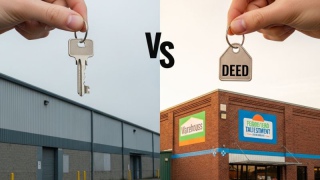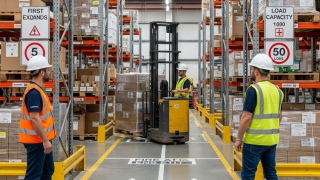Warehouse Racking Systems: A Complete Comparison
In the dynamic world of logistics and supply chain management, efficient warehouse operations are paramount to success. At the heart of a well-organized warehouse lies a robust racking system, designed to maximize storage capacity, streamline inventory management, and enhance operational efficiency. Choosing the right racking system is a critical decision that can significantly impact a warehouse's productivity, safety, and bottom line. This comprehensive guide will delve into the various types of warehouse racking systems, offering a complete comparison to help you make an informed choice for your specific needs.

The Importance of Choosing the Right Racking System
Before we explore the different types, let's understand why this decision is so crucial:
-
Space Optimization: Racking systems are designed to utilize vertical space, dramatically increasing storage density within a given footprint.
-
Inventory Accessibility: A well-planned system ensures easy access to inventory, reducing retrieval times and improving order fulfillment rates.
-
Safety: Proper racking ensures the safe storage of goods, preventing accidents and damage to products or personnel.
-
Operational Efficiency: Streamlined material flow and organized inventory lead to increased productivity and reduced labor costs.
-
Cost-Effectiveness: Optimizing space and efficiency can lead to significant long-term savings in real estate, labor, and product damage.
-
Scalability and Adaptability: The right system can grow and adapt with your business, accommodating changing inventory needs and operational demands.
Key Considerations When Choosing a Racking System
Several factors come into play when selecting the ideal racking system:
-
Type of Inventory: Consider the size, weight, fragility, and shelf life of your products.
-
Inventory Turnover Rate: High turnover items require easy accessibility, while slow-moving goods can be stored in less accessible areas.
-
Storage Density Requirements: How much product do you need to store in a given area?
-
Budget: Racking systems vary significantly in cost, from basic solutions to highly automated systems.
-
Material Handling Equipment: The type of forklifts and other equipment you use will influence the racking design.
-
Building Dimensions and Layout: Column placement, ceiling height, and floor condition are all critical factors.
-
Future Growth: Choose a system that can accommodate your projected growth in inventory and operations.
-
Compliance and Safety Regulations: Ensure the chosen system meets all local and industry safety standards.
Types of Warehouse Racking Systems: A Comprehensive Comparison
Now, let's explore the most common warehouse racking systems:
1. Selective Racking
Description: Selective racking is the most common and versatile type of racking system. It provides immediate access to every pallet in the system, making it ideal for warehouses with a wide variety of SKUs and high inventory turnover. Pallets are stored one deep, allowing for direct access to each load.
Pros:
-
100% Pallet Accessibility: Every pallet is directly accessible, facilitating efficient picking and put-away.
-
Versatility: Accommodates a wide range of pallet sizes, weights, and product types.
-
Flexibility: Easy to reconfigure and expand as needs change.
-
Cost-Effective (Initial Investment): Generally the most affordable racking option.
-
Good for High SKU Variety: Ideal for warehouses with many different products.
Cons:
-
Lower Storage Density: Uses more floor space compared to high-density systems.
-
Requires More Aisles: Leads to a larger footprint for the same amount of storage as denser systems.
-
Less Efficient for Homogenous Products: Not the best choice for storing large quantities of the same item.
Best For: Warehouses with high SKU diversity, first-in, first-out (FIFO) inventory management, and a need for direct pallet access. Examples include general distribution centers, retail warehouses, and manufacturing facilities with diverse product lines.
2. Drive-In/Drive-Thru Racking
Description: Drive-In and Drive-Thru racking systems are high-density storage solutions designed to maximize storage capacity by minimizing aisle space. In these systems, forklifts drive directly into the racking lanes to store or retrieve pallets, which are supported on rails.
-
Drive-In Racking: Operates on a Last-In, First-Out (LIFO) inventory management principle, as pallets are loaded and unloaded from the same side.
-
Drive-Thru Racking: Operates on a First-In, First-Out (FIFO) principle, as pallets are loaded from one side and retrieved from the opposite side.
Pros:
-
High Storage Density: Maximizes floor space utilization, significantly increasing storage capacity.
-
Cost-Effective (Per Pallet): Lower cost per pallet stored compared to selective racking for high-volume, low-SKU operations.
-
Ideal for Bulk Storage: Excellent for storing large quantities of the same product.
Cons:
-
Limited Pallet Accessibility: Only the first or last pallet in a lane is immediately accessible, making it less suitable for high SKU variety.
-
Risk of Damage: Requires careful forklift operation to avoid damage to the racking structure.
-
Requires Specialized Forklifts: Often requires narrower or specialized forklifts for maneuverability.
-
Not Suitable for FIFO (Drive-In): Drive-In is strictly LIFO, which may not be suitable for all inventory types.
Best For: Warehouses storing large volumes of homogeneous products with low SKU variety, such as food and beverage distribution, cold storage, and bulk storage of seasonal items.
3. Pallet Flow Racking (Gravity Flow Racking)
Description: Pallet Flow racking is a First-In, First-Out (FIFO) dynamic storage system that utilizes gravity. Pallets are loaded onto inclined lanes with rollers or wheels, and gravity moves them to the picking end. When a pallet is removed, the next pallet automatically flows into position.
Pros:
-
Excellent for FIFO: Ensures proper inventory rotation, crucial for perishable goods or products with expiration dates.
-
High Storage Density: Reduces the need for aisles, freeing up floor space.
-
Increased Picking Efficiency: Pallets automatically present themselves at the picking face, reducing travel time for operators.
-
Reduced Labor Costs: Less forklift travel and fewer touches per pallet.
-
Energy Efficient: Utilizes gravity, reducing reliance on powered systems.
Cons:
-
Higher Initial Investment: More complex design and components lead to a higher upfront cost.
-
Less Flexible: Difficult to reconfigure once installed.
-
Limited Pallet Size and Weight Flexibility: Requires consistent pallet sizes and weights for smooth operation.
-
Potential for Pallet Jamming: Can occur if pallets are damaged or not loaded properly.
Best For: Warehouses requiring strict FIFO inventory management, such as food and beverage, pharmaceuticals, and manufacturing operations with high-volume, fast-moving products.
4. Push Back Racking
Description: Push Back racking is a Last-In, First-Out (LIFO) high-density storage system that uses a series of nesting carts or rollers on inclined rails. When a new pallet is loaded, it "pushes back" the previous pallet, creating a deep storage lane. When a pallet is removed, the remaining pallets flow forward by gravity.
Pros:
-
High Storage Density: Offers significantly higher storage density than selective racking.
-
Good Pallet Accessibility (Per Lane): While LIFO, each lane provides access to multiple SKUs.
-
Efficient for High SKU Variety (Per Lane): Can store different SKUs within the same lane, unlike Drive-In.
-
Faster Loading/Unloading than Drive-In: Less forklift maneuvering required.
-
Less Prone to Damage: Less contact between the forklift and the racking structure compared to Drive-In.
Cons:
-
Higher Initial Investment: More expensive than selective racking.
-
LIFO Inventory Management: Not suitable for products requiring FIFO.
-
Requires Consistent Pallet Sizes: Optimal performance with uniform pallet dimensions.
-
Less Versatile than Selective: Not as adaptable to diverse product types or rapid changes in inventory.
Best For: Warehouses storing medium to high volumes of medium-SKU variety products that don't require strict FIFO, such as general warehousing, manufacturing, and food processing facilities.
5. Cantilever Racking

Description: Cantilever racking is specifically designed for storing long, bulky, or oddly shaped materials that cannot be easily stored on traditional pallet racking. It consists of a central column with horizontal arms extending outwards, creating open storage levels.
Pros:
-
Ideal for Long/Bulky Items: Perfect for storing lumber, pipes, steel bars, furniture, and other non-palletized goods.
-
Adjustable Arms: Arms can be easily adjusted to accommodate different material lengths and sizes.
-
Easy Access: Open design provides clear access for loading and unloading.
-
Versatile: Can be configured for single or double-sided storage.
Cons:
-
Lower Storage Density (for Palletized Goods): Not efficient for standard pallet storage.
-
Higher Cost (Per Square Foot): More expensive per square foot compared to standard pallet racking if you're not storing long items.
-
Requires Specialized Handling: May require specialized forklifts or lifting equipment for long items.
Best For: Manufacturing plants, lumber yards, steel service centers, and warehouses storing products like pipes, tubes, lumber, furniture, and other non-standard sized goods.
6. Carton Flow Racking
Description: Similar to pallet flow racking, Carton Flow racking (also known as "case flow" or "gravity flow shelving") is designed for smaller, lighter items in cartons, totes, or individual pieces. Items are loaded from the back onto inclined shelves with rollers or wheels and flow by gravity to the picking face at the front.
Pros:
-
Excellent for FIFO: Ensures proper product rotation and freshness.
-
Increased Picking Efficiency: Products are automatically presented at the pick face, minimizing search and travel time.
-
Reduced Labor Costs: Streamlined picking process.
-
Improved Organization: Creates a clean and organized picking area.
-
Space-Saving: Maximizes vertical space for smaller items.
Cons:
-
Higher Initial Investment: More expensive than standard shelving.
-
Limited Weight Capacity: Not suitable for heavy or bulky items.
-
Less Flexible: Can be difficult to reconfigure or adapt to changing product sizes.
Best For: Order fulfillment centers, e-commerce warehouses, retail backrooms, and operations requiring efficient picking of small parts, cartons, or individual items, especially those with expiration dates.
7. Mobile Racking (Compactus Racking)

Description: Mobile racking systems are high-density solutions where rows of conventional racking are mounted on mobile bases that move along floor rails. This eliminates the need for multiple fixed aisles, as aisles are only opened when and where needed.
Pros:
-
Highest Storage Density: Can reclaim up to 90% of aisle space compared to conventional static racking.
-
Significant Space Savings: Ideal for warehouses with limited footprint or high land costs.
-
Increased Capacity: Maximizes storage within a given area.
-
Improved Security (Optional): Can be locked down to restrict access.
Cons:
-
Very High Initial Investment: Most expensive racking option due to the motorized bases and controls.
-
Slower Access Times: Requires time for aisles to open, which can impact throughput.
-
Mechanical Complexity: Requires regular maintenance and can be prone to mechanical issues.
-
Limited Throughput: Not ideal for high-volume, rapid access operations.
Best For: Cold storage facilities, archival storage, high-value item storage, and warehouses with limited space where maximizing density is the absolute priority, even if it means slightly slower access.
8. Mezzanine Racking

Description: While not strictly a "racking system" in the same sense as the others, mezzanine racking involves constructing an elevated platform or second level within a warehouse, effectively doubling or tripling usable floor space. It can incorporate various racking types on both levels.
Pros:
-
Maximizes Vertical Space: Creates additional floor area without expanding the building footprint.
-
Versatile: Can be used for storage, offices, picking operations, or assembly areas.
-
Cost-Effective Alternative to Expansion: Cheaper than building an entirely new facility.
-
Flexible Design: Can be customized to suit specific needs and integrate with other racking types.
Cons:
-
Structural Requirements: Requires sufficient ceiling height and floor load capacity.
-
Building Permits: Often requires additional permits and engineering considerations.
-
Material Flow Challenges: Requires careful planning for vertical material movement (conveyors, lifts).
-
Initial Investment: Can be a significant upfront cost.
Best For: Warehouses needing to expand their usable space without a new building, e-commerce fulfillment centers, and facilities needing dedicated areas for different functions (e.g., storage on one level, picking/packing on another).
Hybrid and Automated Racking Systems
Beyond these core systems, there are also increasingly sophisticated hybrid and automated solutions:
-
Pallet Shuttle Systems: Often used in conjunction with Drive-In or Push Back, these systems use a motorized shuttle that runs within the racking lanes, automatically loading and retrieving pallets. They offer higher density and improved throughput compared to traditional drive-in.
-
AS/RS (Automated Storage and Retrieval Systems): Highly automated systems that use computer-controlled cranes or shuttles to store and retrieve loads. They offer exceptional density, speed, accuracy, and labor savings but come with a very high initial investment.
-
Vertical Lift Modules (VLMs) and Carousels: Automated enclosed systems designed for high-density storage and retrieval of small parts, often used for order picking.
Making the Right Choice: A Step-by-Step Approach
-
Assess Your Current Needs: Analyze your inventory characteristics, turnover rates, available space, and budget.
-
Define Your Future Needs: Consider projected growth, changes in product lines, and evolving operational demands.
-
Prioritize Key Factors: Is maximizing density your top priority, or is it 100% accessibility? Is FIFO essential, or can you work with LIFO?
-
Consult with Experts: Work with experienced racking system providers. They can offer valuable insights, design recommendations, and structural analyses.
-
Obtain Multiple Quotes: Compare costs, features, and lead times from different suppliers.
-
Consider Safety and Compliance: Ensure the chosen system meets all relevant safety standards and building codes.
-
Plan for Installation and Maintenance: Understand the installation process and ongoing maintenance requirements.
Conclusion
Warehouse racking systems are the backbone of efficient storage operations. From the versatile selective racking to the ultra-dense mobile systems, each type offers distinct advantages and disadvantages. By carefully evaluating your specific inventory, operational needs, budget, and future growth plans, you can select the optimal racking solution that maximizes your warehouse space, enhances productivity, and ultimately drives your business success. Investing in the right racking system is not just about storing goods; it's about optimizing your entire supply chain for greater efficiency and profitability.
_0x70_d59.png)



